Bichig Mongolian", a thousand-year-old script in survival mode

Origin of Mongolian bichig
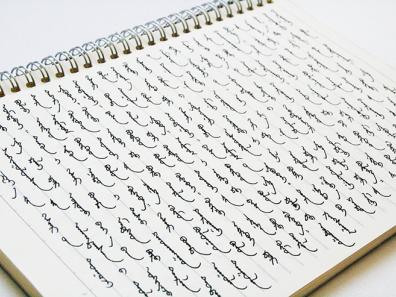
Several hypotheses have been put forward as to the origins of this Semitic script. The Mongol alphabet may have been borrowed by the Mongols from the Uyghurs in the early 13th century, when Genghis Khan's empire was being built. The Yuanshi, a Chinese historical text written in 1370, mentions that the instruction of Genghis Khan's sons was provided by a Uyghur scribe named Tatatonga. This scribe from the Naiman tribe, defeated in 1204, used this alphabet and thus contributed to its spread. Another hypothesis, put forward by the historian Ts. Shagdarsüren, this alphabet was borrowed around the 5th century by both the Uyghurs and the Mongols from the Sogdian script, itself of Aramaic origin. Whatever the case, its use seems to have become widespread in the early 13th century, when it became necessary to administer the vast territory that was the Mongol empire. Mongol bichig remained the official Mongolian script until the beginning of the 20th century.
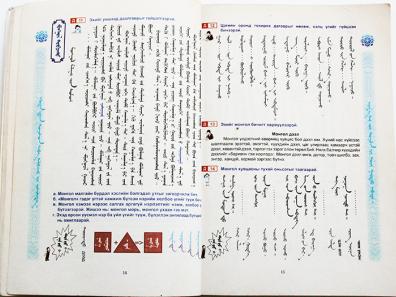
Characteristics of mongol bichig
The mongol bichig, also known as "Uyghur script" (uigarjin bichig), "khudam script", "ancient script" (khuuchin bichig), "national script" (ündesnii bichig) or "vertical script" (bosoo bichig), is an alphabetical script that is read from top to bottom and left to right. Its alphabet comprises 33 letters - 7 vowels, 17 consonants and 9 letters reserved for the notation of consonants in words of foreign origin - each of which comes in three versions depending on their position in the word (initial, medial or final).
Phoenemes such as a/é, o/u, ö/ü or even d/t, j/z, ts/ch are noted by the same letter, enabling an understanding that transcends Mongolian dialectal differences. What's more, since mongol bichig is based on the language's morphology, it preserves the language's linguistic structure, providing an immense field for lexicographical, etymological and historical exploration of the Mongolian language. Like French, however, the mongol bichig reflects relatively little the pronunciation of the actual Mongolian language.
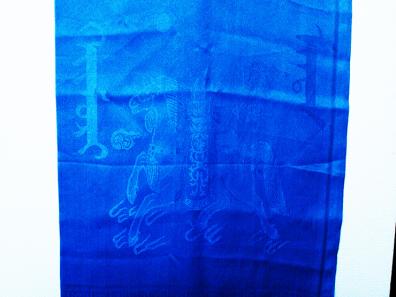
"Inscription from the Genghis Stone"
The oldest Mongolian text written in mongol bichig found to date is the "Inscription from the Genghis Stele", discovered in the present-day Republic of Buryatia (Russian Federation) in 1802. It is a text of 21 words in 5 lines dedicated to Yesünge mergen, the son of Khasar (Genghis Khan's younger brother). The text reports that he had shot a bow and arrow from a distance of 335 fathoms (over 612 meters) during a festive gathering that Genghis Khan had organized on his return to his homeland, after conquering Khârezm in 1225. The granite stele is 202 cm high, 74 cm wide and 22 cm thick, and is housed in the Hermitage Museum in St. Petersburg.
Changing from mongol bichig to Cyrillic in the 20th century
As Mongolia became a satellite country of the USSR, the latter's radical leftist policy led to the stigmatization of Mongolian writing as a cultural element of aristocrats and religious (Buddhist) people as early as the 1920s, as opposed to the rest of the population, then mostly illiterate. The Comintern succeeded in convincing people of the obsolescence of the mongol bichig to strengthen Soviet political influence in Mongolia. In 1925, the IVth Congress of the Mongolian People's Revolutionary Party (MPRP) announced that its aim was to "make Mongolian writing easier". In 1930, the eighth congress of the PRPM adopted the Latin alphabet, "close to the new culture", and called for its widespread use by 1932, but this objective was not achieved. Despite attempts to introduce this alphabet throughout the 1930s, the 1941 meeting of the PRPM Central Committee and Council of Ministers announced, under political pressure, that the mongol bichig would be abandoned in 1944, to be replaced by the 35-letter Cyrillic alphabet (two letters longer than Russian).
In 1945, the Central Committee of the PRPM and the Council of Ministers reconvened, noting that only 20% of the population had learned the new script, and announced a new goal: the use of Cyrillic in all state affairs and publications from 1946. As a result, in 1962 Mongolia became the first country to eradicate illiteracy through a combined policy of compulsory schooling and simplified writing.
On the other side of the Mongolian-Russian border, the Buryats, the northernmost Mongolian people, underwent the transition to Cyrillic (with 36 letters[1]) as early as the 1930s - before the Mongols of Mongolia - while to the south of Mongolia, in Inner Mongolia, the Mongols of China will retain the mongol bichig until today, doing without Cyrillic.
In the early 1990s, Mongol Bichig was revitalized in Mongolia, as the Mongolian and Soviet socialist regimes collapsed. While there has been talk of reintroducing Mongol Bichig as the official script in Mongolia, this issue has been relegated to the background due to government instability and an extremely fragile socio-economic situation, effectively hindering the mastery of this script by the population at large.
The mongol bichig nevertheless continues to be taught as a subject in its own right in Mongolian secondary schools. In addition, the Mongolian government has taken several steps to revitalize this script, through a succession of national programs: "Mongol bichig-1" (1995-2005); "Mongol bichig-2" (2008-2015); the Mongolian Language Law (2015) and "Mongol bichig-3" (adopted in 2020). Since 2013, the calligraphy of this script has been included on UNESCO's List of Intangible Cultural Heritage in Need of Urgent Safeguarding
.
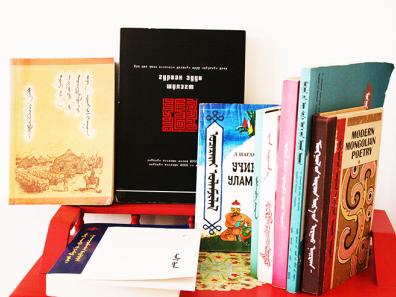

Accelerating revitalization?
At a time of renewed nationalist movements, the Mongolian script is increasingly being promoted as a specificity, a marker of cultural identity, and the only script capable of noting the subtleties of the Mongolian language. It is widely used in the arts: painting, calligraphy and decorative objects.
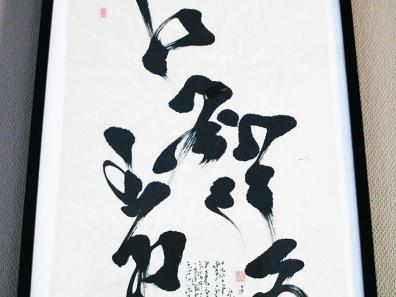
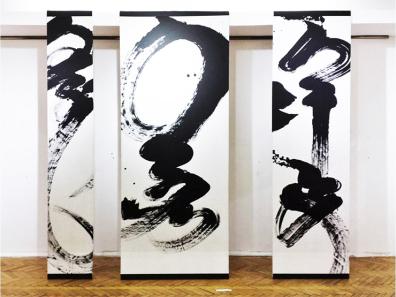
In September 2020, the Chinese government announced that the majority of lessons previously taught in Mongolian in certain schools in Inner Mongolia would henceforth be replaced by lessons in Mandarin. This policy, perceived as forced assimilation, provoked protests and violence in Inner Mongolia, but also a great stir in the Republic of Mongolia, and elsewhere in the world: in the USA, Japan, Sweden and France, demonstrations and public rallies in solidarity were numerous despite Covid, as was the use of the hashtag #SaveTheMongolianLanguage. Indeed, the disappearance of the Mongolian language and script in China would mean an irreversible loss of over 60% of its speakers worldwide.
The Mongolian government announced in 2015 the return of mongol bichig as the official script in Mongolia from 2025. In recent years, the use of mongol bichig has been appearing timidly on social networks, while publications in this alphabet are slowly multiplying in Mongolia. An initial nationwide survey conducted in 2021 on the mastery of mongol bichig among civil servants reveals that 85% of them require training in this script. The magnitude of the challenge, commensurate with the stakes involved in preserving the mongol bichig.

And at Inalco?
Insofar as we teach the so-called "standard" Mongolian at Inalco, currently in use in the Republic of Mongolia, students are trained in Cyrillic grammar and written and oral practice. They nevertheless benefit, as in Mongolia, from dedicated teaching of mongol bichig, at the rate of one and a half hours per week, from L1.
Charlotte MARCHINA and Nomindari SHAGDARSUREN
Charlotte MARCHINA, senior lecturer in Mongolian language and civilization. Portrait.
Nomindari SHAGDARSUREN, lecturer in Mongolian language.
Bibliography
C. Atwood, Encyclopedia of Mongolia and the Mongol Empire, Facts on File, New York, 2004.
E. Mönkh-Uchral, "Mongolchuudyn bichgiin soyolyn tüükh [History of Mongolian writing culture]", Ekh khel bichig [Mother tongue and writing], No. 1, Institute of Language and Literature, Mongolian Academy of Sciences, Ulaanbaatar, 2012.
S. Nyamdorj, Mongol bichgiig khalakh bodlogo: Shaltgaan, kheregjilt, ür dagavar [The policy on abandoning traditional Mongolian writing: reasons, implementation, consequences], Ulaanbaatar, 2012.
J. Legrand, Parlons mongol, L'Harmattan, Paris, 1997.
Ya. Nadmid, Mongol bichgiin zöv bichikh tol' bichig [Orthographic dictionary of traditional Mongolian script], Ulaanbaatar,1990.
N. Urtnasan (ed.), Mongol ündestniibiyet bus soyolynöv [The intangible cultural heritage of the Mongols], Ulaanbaatar, 2010.
Online articles and websites
B. Jargalmaa, "Sudalgaa: Töriin alban khaagchdyn 46% n' ündesnii bichgeer alban khereg khötlökhod belen bish, 85%-d n' surgalt kheregtei [Study: 46% of civil servants are not ready to use the national script in official documents, and 85% would need training]", https://ikon.mn/n/29re
http://mongol-bichig.dusal.net/
Note
[1] The Buryat language has an additional sound compared to standard Mongolian, or khalkh: the aspirated "h", noted by this same letter.